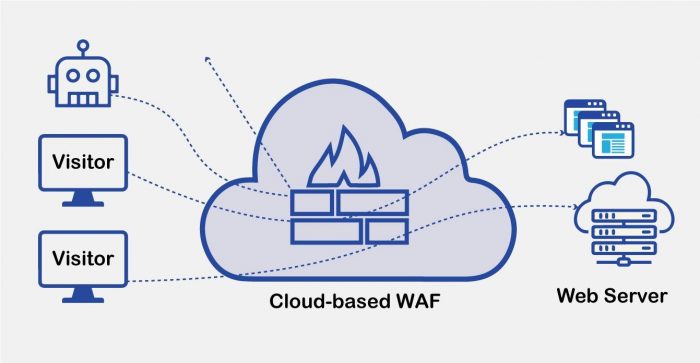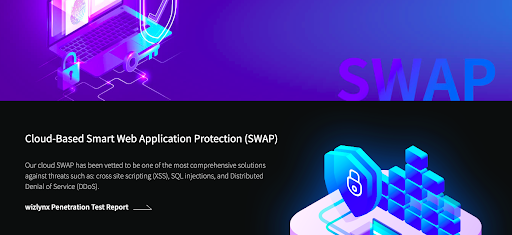There is no autopilot on a Web Application Firewall (WAF). An automatic turn/off button that sets your WAF to do all the work while you forget about security.
If you don’t want to risk DDoS, XSS, SQL injection attacks, you will have to grab the manual control and start deploying, configuring, and operating your WAF. But this is no task for the ordinary web admin. Depending on the application, managing a WAF can take intensive resources and personnel.
A fully-managed WAF removes that responsibility.
1. Web Application Firewalls (WAFs)
WAFs were designed to protect web applications from new and dangerous threats coming from the public Internet. The WAF monitors and filters all HTTP traffic before it gets to your web server. This layer between your web app and the Internet ensures protection from common web exploits like SQL injection, DDoS, XSS, and more. WAFs can be delivered as on-premise hardware appliances, software, virtual servers, and cloud-based WAFs. Cloud WAFs are the ones growing most in popularity. The reason is that most organizations, including SMBs and enterprises, are moving a significant percentage of their applications’ workloads, along with their security, to the cloud.  Cloud WAFs are usually offered via two different models, SaaS (Managed Service) or Fully-Managed Service.
Cloud WAFs are usually offered via two different models, SaaS (Managed Service) or Fully-Managed Service.
2. Cloud-based WAFs: SaaS vs Fully Managed-Service.
We all probably know SaaS —the Internet-based applications hosted in the cloud and offered as a service. SaaS provides the software along with its benefits in a subscription-based model. Most SaaS-based applications, like a self-managed cloud-based WAF, will still have you doing most of the housekeeping. These traditional cloud WAFs are not set-it-and-forget-it settings, where you create a filter and let it automatically catch the bad traffic. You and your team will need to be 100% immersed in the WAF deployment, configuration, and operations. Why are self-managed WAFs so challenging? The initial deployment of the WAF and settings of its security policies, filters, and rules can be resource-consuming, both in terms of time and expertise. Plus, the ongoing operations, including everyday tasks like maintenance and monitoring of WAF alerts and log data, will require someone in-house to be fully dedicated to managing the WAF.
A Fully-Managed Service is Different.
Although it falls under the same umbrella as SaaS, the level of service and support is fine-grained and sometimes even personalized. A fully-managed WAF service goes beyond the WAF-based self-managed SaaS, as they do much of the intensive housekeeping so that you can focus on the core of your application development and not entirely on its security.
How a Fully-Managed WAF Service Goes Beyond?
The fully-managed WAF service transfers more authority and responsibility to the provider. You won’t have to put the initial effort into deploying policies and filters. Additionally, you’ll also be less involved in alerting and monitoring. This approach has three clear advantages: Convenience, Lower OpEx (Operational Expenses), and access to five-star expertise.
1. Convenience:
Although fully managed WAFs are neither set-it-and-forget-it settings, they’ll give you more independence from your web application’s security. You don’t have to think about deploying and managing your WAF; the service provider is responsible for all of that. Of course, security is a sensitive topic. Having a fully-managed service doesn’t mean you can forget about your app’s security. With this in mind, a fully managed WAF provider should take responsibility, but not total control. There are still specific tasks that should be under your control, like dealing with unique threats, having you the big picture of the security, or informing you with full details on events.
2. Lower Operational Expenses:
To take the most out of a typical managed-service SaaS-based WAF, a security team would need to be fully involved in its deployment and everyday operations, like deploying policies, configuring WAF rules, monitoring alerts, reporting, etc. With a fully-managed service, you are transferring that responsibility to a provider that already has the expertise. A fully-managed cloud WAF service not only lowers OPEX by cutting down maintenance expenses, but it also allows you to repurpose IT teams into more meaningful tasks, like development and innovation.
3. Access to WAF Experts.
Most self-managed WAF providers will not handle any deployment, configuration, or monitoring. You will have to know or hire somebody that knows about web security issues and WAF implementation. On the other hand, fully-managed services give you access to their in-house team of experts ready to provide support.The highest levels of expertise and support are from those service providers that are also solution developers. Instead of going through a third-party “customer service” provider, the solution developer has the technicians, the knowledge, and the full expertise.
A Fully-Managed Smart Web Application Protection.
An example of a fully managed autonomous cloud WAF service is Cloudbric WAF+(
A fully managed Web Application Firewall). WAF+ runs on a proprietary logic analysis engine, developed in-house, to block the most sophisticated web threats.
Cloudbric WAF+’s logic-based detection engine improves speed and lowers false positives by not relying on signature-matching technology. The engine recognizes the attack’s logic and immediately blocks it.

WAF+ is known for being one of the few solutions capable of stopping new threats on cross-site scripting (XSS), SQL injections, and Distributed Denial of Service (DDoS).
WAF+’s Fully Managed Service Features:
- Reduce WAF’s operations complexity. Signature-less technology helps eliminate operation challenges by lowering false positives. WAF+ is different from most cloud-based WAFs because it uses VISION’s deep learning capabilities to learn about new web attack patterns and keep false positives substantially lower.
- No need to fine-tune WAF policies and rules. WAF+ provides 28 unique WAF rules that proactively monitor traffic and stop threats. These rules are developed in-house and do not require you to be continually updating attack signatures.
- Reporting. When WAF+ identifies abnormal traffic, it blocks it and saves the logs of the event. WAF+ will send you a security report on all of your attempted attacks.
- 24×7 support. WAF+’s fully managed service comes with 24×7 access to technical support and expertise. This support includes hands-on engineers dedicated to keeping all website and WAF+ instances online. The team are also developers and have in-depth knowledge of WAF and application vulnerabilities. Support is delivered via Help Center.
- You still hold control. You or your security admin can log into the WAF+’s console to obtain more visibility into the security and customize threat responses. WAF+ will notify you when a threat requires a unique response. Additionally, you also have full access to the console and dashboard so that you can know details about past attack events.
To learn more, visit Cloudbric WAF+.






